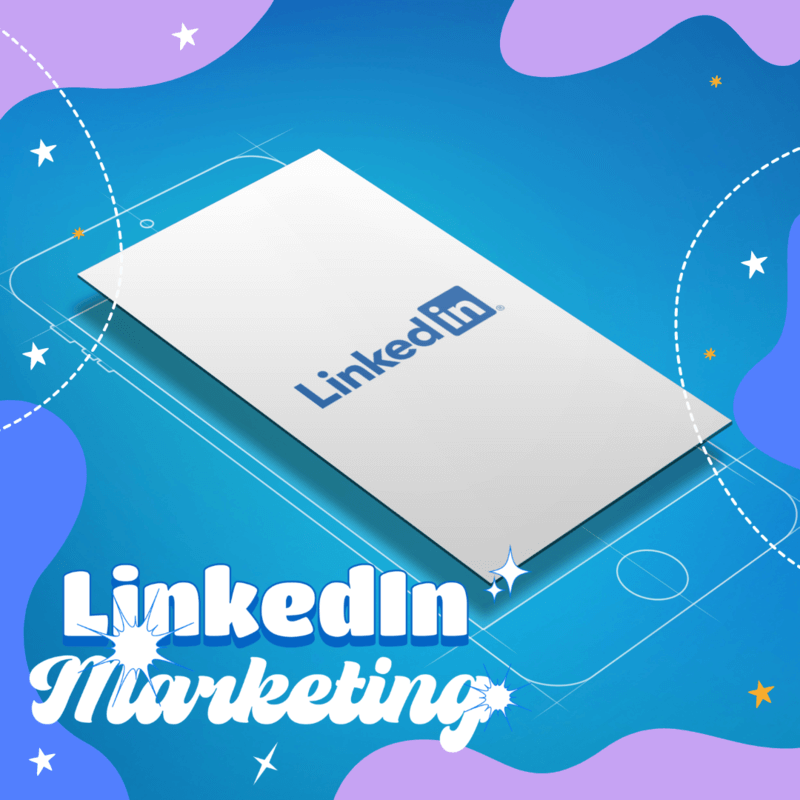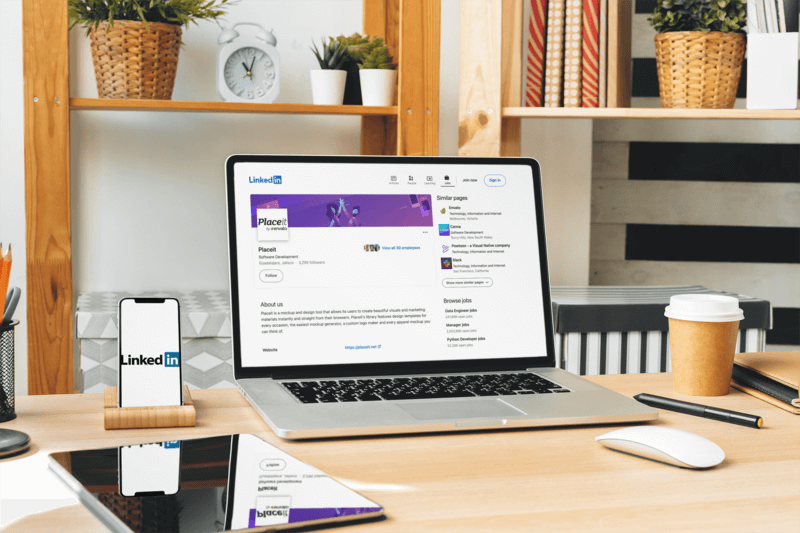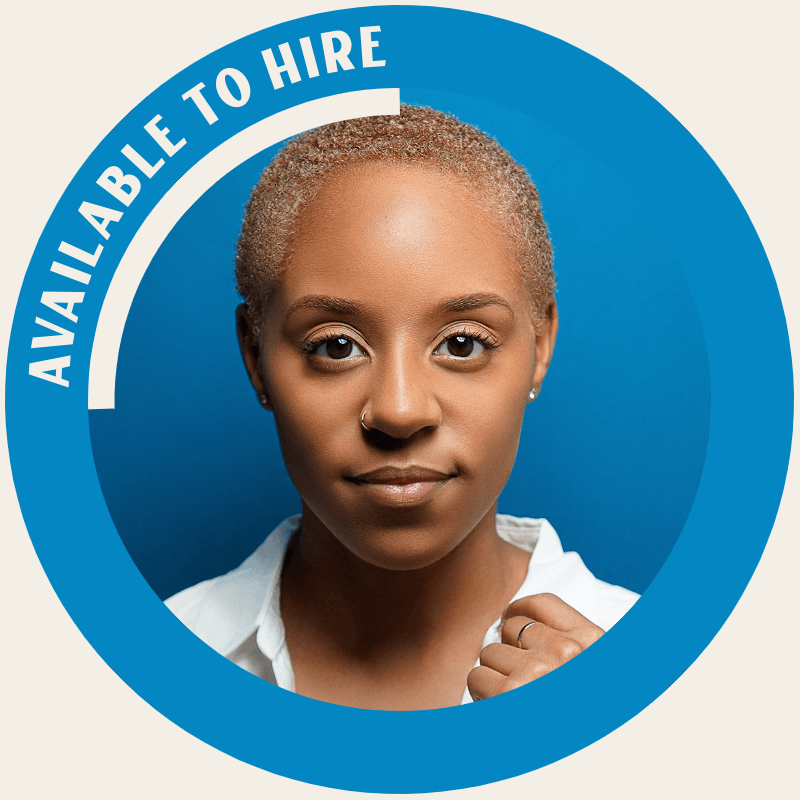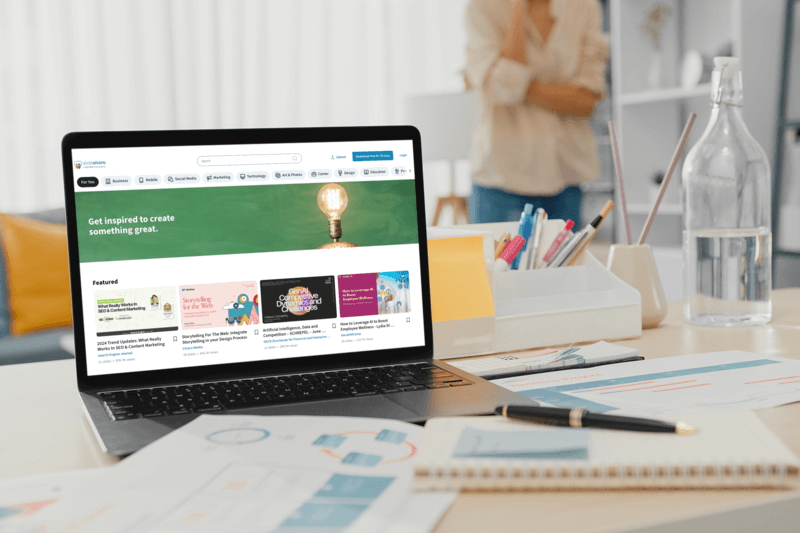
Social media is no longer an afterthought when it comes to content marketing —it is the main stage where brands, freelancers, and professionals shine. If you’re not prioritizing it, you’re already falling behind! Enter LinkedIn marketing! ✨
Did you know that LinkedIn hires six people every minute? This makes it one of the number one platforms for B2B marketing and professional networking. But are you truly making the most of LinkedIn marketing?
If your answer is “no”, no worries! In this 2025 LinkedIn Marketing Guide, we’ll dive into expert tips for leveraging this platform, building meaningful connections, driving lead generation, and converting more customers.
Ready to build a successful LinkedIn marketing strategy? Let’s get to it! 😌
LinkedIn Growth Starts Here —Find What You Need 🔎
- Before We Start — Understanding LinkedIn Marketing 💡
- How to Do LinkedIn Marketing Effectively? 😌
- 1. Fill Out Your LinkedIn Profile for Maximum Impact
- 2. Build a Valuable Network
- 3. Switch up Your Content Strategy
- 4. Build a Personal Brand on LinkedIn
- 5. Drive Engagement With the LinkedIn Publishing Platform
- 6. Keep Your LinkedIn Active
- 7. Expand Your Reach With the Right Hashtags
- 8. Join LinkedIn Groups and Actively Participate in Them
- 9. Unlock Key Insights With LinkedIn Analytics
- 10. Consider Investing in LinkedIn Ads to Scale Up
- Make LinkedIn Marketing Work for You ✨
Before We Start — Understanding LinkedIn Marketing 💡
Before we jump in, let’s start with the basics In short, LinkedIn marketing refers to the strategy of using this platform to:
🎯 Connect With Your Target Audience
🤩 Build Brand Awareness
🚀 Generate Leads
💻 Drive Traffic to Your Website
👩🏻 Guide Prospects Down the Sales Funnel
But how can you achieve a successful LinkedIn marketing strategy? We’re glad you ask! A starting point is sharing relevant content with your audience and engaging them in your posts. As we mentioned in our 2025 Social Media Trends guide, LinkedIn has adopted a more relatable approach, highlighting the authentic and human side of work experiences. 😀
But there are other methods, too, such as LinkedIn ads or outreach messages on the networking site. In fact, you can use a LinkedIn email finder to streamline this outreach process and find the right contacts to connect with.
➡️ Not Your Average Social Network

While other social platforms like Facebook or Instagram are great marketing channels, there is a major difference between them and LinkedIn. This distinction relies on the first platforms being used as a source of entertainment, while LinkedIn is employed to network with fellow professionals, gain industry insights, learn about industry trends and developments, and more.
In short, this makes it a great medium for B2B content marketing, as it delivers better outcomes through these efforts. Since you can reach out to business leaders and decision-makers on LinkedIn, it significantly increases your chances of generating leads.
That being said, the approach to LinkedIn marketing has to be different than what you use for other social media marketing efforts.
So, without further ado, let’s take a closer look at our LinkedIn marketing guide.
How to Do LinkedIn Marketing Effectively? 😌
Networking 101: LinkedIn Marketing Tips for 2025 ✏️
2025 is an important year for most businesses as trends such as the implementation of AI, adaptable workforces, and emotional branding arise. Of course, we can’t forget to mention the comeback from the global economic slowdown and the after-effects of the COVID-19 pandemic.
📌 Here are some essential LinkedIn marketing tips to follow in 2025:
1. Fill Out Your LinkedIn Profile for Maximum Impact
Remember, first impressions matter! So, the first step in building a solid LinkedIn marketing strategy is creating a profile that appeals to your prospects. Irrespective of whether you are operating with a LinkedIn account as an individual or as a business, having a complete and impressive profile is crucial. Here’s what to do:
The Do’s 🙂
- Include all the vital information to describe what you or your business does. Share your professional journey, accomplishments, and aspirations. Additionally, highlight your skills by incorporating relevant keywords to optimize your profile and increase your visibility in search results.
- Onto our LinkedIn photo tips! Use a profile image that’s professional and represents your brand. If you opt for a headshot, make sure to use a high-quality picture with good lighting and a neutral background. On the other hand, if your profile represents your business, aim for cohesive visual branding by including your logo.
✨ Need some inspo? Here are some examples of how your LinkedIn profile picture should look like:
📌 Quick Note: The best size for your LinkedIn profile picture is 400 px x 400 px or a 1:1 size ratio.
- Have a relevant LinkedIn background banner on your profile to make it look complete and polished. Ensure this image is visually appealing and related to your industry and personal brand. Not a creative expert? Don’t worry! There’s no need to start designing from scratch, take a peek at the LinkedIn banner templates Placeit by Envato has for you:
📌 Pro Tip: Your LinkedIn banner size should be 1584 px x 396 px.
Spotlight On: The “About” Section 🌟
The “About” section is key for a complete, professional, and compelling LinkedIn profile. This is both for individual accounts and business pages. It should be carefully crafted to include all key points, such as:
💼 Profession / Job Title
🧑🏻💻️ Industry
💡 Expertise
✏️ Skills
🎓 Wins
💬 CTA
📌 Friendly Reminder: All the other fields where you can share information about yourself or your business should also be filled in. Keep in mind that the LinkedIn algorithm usually recommends people you can connect with based on this data.
2. Build a Valuable Network
Once your LinkedIn profile is complete, the next step is to start building your network. Look for people who fit into your target buyer persona. Ideally, you should have a list of businesses or people you want to connect with or at least a criteria you can use to narrow down your prospects.
Implement these LinkedIn tips to connect with purpose and grow your network:
Ensure the profile you want to network with is authentic. Pay attention to the quality of their profile (is it complete?), their work experience, and connections.
Adding a personal touch when sending a LinkedIn invitation shows you’ve taken the time to review the user’s profile and want to forge a genuine professional connection. Always start with a greeting, state why you want to connect and be courteous.
While accepting every invitation may seem intriguing, you’ll be losing focus, possibly ending with an overload of spam messages. Instead, search for industry-related experts who provide valuable insights within your field and niche.

Choosing your connections smartly is critical because these are the people you are trying to turn into leads. Moreover, adding relevant professionals as connections allows you to tap into their networks and increase your reach further. 😌
😵💫⏰️ Distractions everywhere? Take control of your workflow and boost productivity with these 7 Tips On How to Stay Focused When Working From Home.
3. Switch up Your Content Strategy

After these initial steps, the next important thing to focus on is the content you publish on LinkedIn. Diversify your content marketing strategy and include different types of posts. It is seen that long-form, informational posts do quite well in engaging the audience. ✏️
However, that doesn’t mean every post should be educational or excessively long. That can bore your followers quickly. 😴 Instead, alternate between:
- Written Posts
- Articles
- Images
- Carousel Posts
- Videos
Giving your audience a variety of content to engage with will keep their interest alive. Despite being a professional networking platform, content like memes and occasional funny posts can do quite well, too.
🤔🪄Struggling to stand out? Visual content might be your secret weapon! Read The Importance of Visual Content for the why and how!
🛠️ Must-Have Content Marketing Tools for 2025
Here are a few tools and platforms to support your LinkedIn content marketing strategy, helping you create diverse posts.
🌟 Narrato
Narrato is an all-in-one AI content creation platform that lets you plan, create, optimize, and publish content seamlessly. It helps with all types of content, including social media content. An interesting feature of this platform is the AI writing assistant that can generate content for various use cases. It can help you create social posts based on your input or an outline. 📱
Besides that, it can also paraphrase existing content from your blog posts and then use it in your social media posts. You can use this AI writer to generate LinkedIn content in several other ways, including creating ad copy. ✏️
Narrato also has an AI content optimization tool that offers grammar and readability improvement suggestions. Additionally, you can create custom content templates to structure your posts as well.
For content planning, you can use the content calendar on the platform to map out your posts well in advance. Content publishing is also a breeze, as you can automate publishing on any social platform through custom integrations using Narrato’s API or Zapier.
🌟 Placeit by Envato
Placeit by Envato is another highly useful tool to boost your LinkedIn content marketing strategy. This no-code design tool lets you create stunning visuals for your social posts. The platform has hundreds of templates for social media banner ads, posts, headers, etc. Additionally, you can narrow your search by relevant categories to find just what you’re looking for. 🔎
Once you’ve chosen your template, you can fully customize it in an easy-to-use editor that allows you to play with colors, text, fonts, animations, transitions, images, and more. Moreover, it allows you to explore relevant designs and choose between images, videos, or transparent template types. ✨
Diversifying your content will be extremely easy with a tool like this! 😌
🌟Piñata Farms
Piñata Farms is a meme-making app. Since memes are such a popular content type on social platforms, including LinkedIn, this tool is a welcome addition to any content marketer’s tool stack. In a nutshell, Piñata Farms lets you create eye-catching images and video memes with no required expertise in graphic design.
The editor on this app is also extremely user-friendly. It has a vast database of all the trending and evergreen memes for you to choose from. On top of that, you can directly share your memes on social media from the app itself. 🤳🏻
🌟 SlideShare
Though SlideShare is not really a content creation tool, it can support your LinkedIn content strategy nonetheless. The slideshows you publish on SlideShare can easily be attached to your LinkedIn posts. These appear as slider presentations, making it another interesting content format to diversify your strategy.
4. Build a Personal Brand on LinkedIn
As you begin building your network, you’ll find that creating a personal brand is key when it comes to the image you project and what you bring to the table. It helps establish your credibility and sets you apart in any professional field. But personal branding isn’t just about the role you have, it’s about highlighting your passions, values, skills, and strengths.
While LinkedIn is a networking platform, it thrives on real, authentic content, much like other social media. But what does this mean here? Though sharing your achievements might seem appealing, it’s just as important to share the struggles and challenges you’ve faced in your career. Why? Because it fosters genuine connections and builds trust.
💡 Pro Tip: When creating content from scratch or reposting from others, carefully select what aligns with your personal brand, meaning it reflects your values and professional image. This ensures consistency and authenticity in the image you’ve built and the message you share with your network.

5. Drive Engagement With the LinkedIn Publishing Platform
The good thing about content marketing on LinkedIn is that it’s not limited to just short posts or images, unlike other social platforms. Instead, you can also create and publish full-blown articles. And this is where the LinkedIn Publishing Platform comes in! ✨
Like a blog, the LinkedIn Publishing Platform allows you to share more valuable content with your audience, thus building more authority for your brand. You can also share articles from your blog via LinkedIn Publishing or from a third party. However, third-party articles should be duly credited.
LinkedIn Article
Content Type
Best For
Length
SEO
LinkedIn Post
Content Type
Best For
Length
SEO
6. Keep Your LinkedIn Active
To post or not to post, that is the question. Posting frequently and regularly is essential on any social channel as it helps you maintain your relevance and gain leverage. So, your posting schedule is just as important as the content you publish on LinkedIn. 💻✏️
The best way to do this is by having a content plan ready. Don’t know where to start? No worries! We have your back. Here’s our advice on how to post consistently on LinkedIn for a top-tier marketing strategy:

🗓 Create a Content Calendar. List down all the posts you want to publish in the upcoming week or month. This will give you a roadmap to follow and ensure you don’t skip any days. It also allows you to define your content goals. Whether it’s brand awareness or thought leadership, sticking to a consistent content schedule will give you a clear objective that will steer your strategy.
⏰️ Find Out What the Best Time for Posting Is. Keep an eye out for your LinkedIn Page Analytics. You might see better engagement on your posts when published at a certain time and lower engagement on others. Use this info to identify which schedule works best for you.
♻️ Repurpose Your Content. You’re probably investing a lot of time and effort into brainstorming, designing, and promoting your content. The good thing is you can maximize your content’s lifespan by repurposing it. For example, you could turn blog posts into short, engaging clips containing all the key info from that article.
😊📅 Stay on track and plan the perfect LinkedIn schedule with these 9 Tips to Create a Social Media Calendar.
7. Expand Your Reach With the Right Hashtags
On LinkedIn, you can add hashtags to your published posts, articles, status updates, or even your profile page to enhance your brand’s reach. However, it’s important to note that the kind of hashtags that work on Instagram and other social media platforms might not cut it here. To do it right, do the following:
#SmartStrategy
- Make the most out of the LinkedIn search bar to find relevant keywords that are popular among your industry, niche, and type of business.
- Research your LinkedIn audience to find out what kind of hashtags they’re looking for and follow trends within your industry to ensure your posts resonate with the right people.
- Capitalize each word of the hashtag for better readability and accessibility, making it easier for users to read and engage with your content.
- Leverage a combination of general and niche hashtags to broaden your reach while targeting your audience.
- Analyze hashtag performance by tracking engagement on your posts and adjusting your future content accordingly.
- Stick to 1-3 strategic hashtags per post to keep them relevant and avoid looking spammy.
8. Join LinkedIn Groups and Actively Participate in Them
LinkedIn Groups present an excellent opportunity for networking and enhancing your brand’s reach. But there is a catch to this – you can’t join these LinkedIn Groups with your company profile. So, if you do want to share your content on this place, it has to be done strategically.
Here’s a mini step-by-step guide for making the most out of LinkedIn Groups:
- Compile all the groups you’re interested in joining, and also collate the names of your content team members.
- Whenever you publish a new content piece, identify which group it would be most suitable for. Get the right team members involved in the job.
- When sharing your content, start an on-theme discussion in the group by adding an opinion or asking a question. Make sure to ask your team members to get involved in the conversation.
- Try to stay away from marketing pitches and provide valuable responses to any comments.
📌 Quick Note: At the end of this exercise, if you do find any users who might be interested in your product/service. Then, connect with them personally to ask them to test out your product.

9. Unlock Key Insights With LinkedIn Analytics

You need to re-examine your LinkedIn marketing strategy from time to time to see how well it’s doing for you. The best way to go about it is by looking at LinkedIn Page Analytics, which allows you to gauge your post trends across time periods and metrics such as:
The total times your post was seen.
The number of unique clicks on your content by a unique signed-in user.
Including reactions, comments, and reposts made by LinkedIn members.
The ratio of interactions per impression on your post.
To dive deeper into LinkedIn Analytics, you can connect LinkedIn Ads to Looker Studio or other data visualization platforms using third-party integrations. This gives you a detailed analysis and the ability to create live dashboards to get an overview of your metrics and create in-depth reports.
To recap, LinkedIn Analytics allows you to:
✅ Test your content’s effectiveness
📍 Find out the sources and demographics of visitors/followers
🔎 Compare your content engagement and followers with competitors
…among other things!
10. Consider Investing in LinkedIn Ads to Scale Up
With LinkedIn Marketing Solutions, you can launch an ad campaign, thus engaging with potential customers and building your network connections. Keep in mind that you’ll need to create a LinkedIn page beforehand, but once is all set up, it is really easy to start advertising!
We recommend you check out this guide on How to prepare for your first LinkedIn ad campaign. Done? Go ahead and do this to launch your very first LinkedIn ad campaign:
- Sign in to Campaign Manager, click on “Create” > “Campaign”.
- Create a campaign group by filling out details like its name and whether it will be active once you set up the date or remain on the drafts.
- Choose your objective according to your business goals. LinkedIn grants you options like “Brand awareness”, “Lead generation”, or “Engagement”.
- Define your target audience by determining which professional traits like job title or industry title you want your ads to be aimed at.
- Pick out your ad format, you’ll be able to choose between Sponsored Content, Message Ads, or Text Ads. You’ll also be asked to select your ad placement.
- Select the budget, bidding strategy, and campaign schedule.
- Set up your ad and upload any necessary creative assets according to the format’s requirements and specifications.
- Enter your payment method, once you’ve saved all the necessary information, your campaign will go through a review process before launching.
💡😊 Keep Reading: Create Ads That Are Guaranteed to Generate More Leads
Make LinkedIn Marketing Work for You ✨
LinkedIn is a powerful networking platform offering new ways to publish and share your content with your target audience. With the tips provided in this article, you can now build a LinkedIn marketing strategy that makes an impact.
A successful LinkedIn strategy requires a long-term commitment to delivering relevant and quality content that increases brand awareness and also engages with your visitors. So, stay consistent and continuously improve on your strategy for incremental growth.
Of course, the conversation isn’t over yet! Have you discovered any unique LinkedIn hacks that have boosted your business? Feel free to share your comments and thoughts below. 😀

Meet the Author!
Neelam Goswami is a content creator and marketer at Narrato – a leading AI-enabled content platform. She has written for several reputed brands in the digital and content marketing space, including ClickUp, Jeff Bullas, Neal Schaffer, Content Studio, and others.
FAQ — The Ultimate LinkedIn Marketing Guide for 2025
- Complete your profile. Use relevant keywords so that you are easier to find.
- Build your network. Find people who fit your buyer persona and target audience so that you can start growing your reach.
- Create diverse content. Don’t stick to just one type of post. Instead, experiment with images, videos, carousels, text posts, long posts, short posts, etc.
- Build a personal brand. Highlighting your skills, passions, and values will help establish your credibility and set you apart in any professional field.
- Use the LinkedIn Publishing Platform to drive engagement. This allows you to create and post long-form content, like blog posts, directly on LinkedIn.
- Keep a consistent posting schedule. Just like on any other social media platform, you have to post regularly and consistently to get picked up by the algorithm. Create a content calendar to help you stay on top of this.
- Use popular and relevant hashtags. Make your posts discoverable for your target audience.
- Join LinkedIn groups and actively participate in them. This will help you grow your community and reach in a more organic way.
- Use LinkedIn Analytics to stay on top of your performance. Use what you learn to shift your marketing strategy so that it’s effective.
- Consider investing in ads. This is a great way to ensure you reach new users and expose them to your brand.
- Profile: Be sure to fill out your company profile thoroughly to give your company legitimacy and so users can get to know you. Optimize your profile and use relevant keywords that will help your company come up in searches.
- Groups: Join different groups and interact with LinkedIn users to grow your reach.
- Network: Add people to your network to grow your reach and influence. With a wider network, you are more likely to see positive results.
- Showcase Pages: Create pages for specific products that different segments of your audience are interested in. This will remove unnecessary information while allowing you to target a specific buyer persona’s needs.
- In-Mail: Connect with your network and even run ads through LinkedIn’s messaging service to reach your target audience and establish communication with interested users.
This isn’t a simple yes or no question because the return on investment for LinkedIn ads can vary depending on how you use them. The type of ads you run (image vs text vs video, etc), what your intent is (exposure vs conversions, etc), and how well you define your target audience can all make a huge difference. It’s important to experiment with these different options to see what works best for you.
Some people worry that LinkedIn ads won’t be worth it because they tend to be more expensive than ads on other platforms, but they also boast a 6.1% conversion rate in the US, which is much higher than it is on other platforms. Of course, it can take some attempts before you see these types of numbers as you will need to work out what types of ads are best for your brand.
In the end, it is worth it but keep in mind it can take time to get it right.









